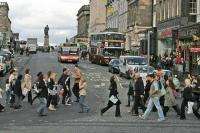November 16, 2010 report
Pedestrians follow the herd instinct when crossing the road

(PhysOrg.com) -- A Leeds University study has discovered pedestrians are likely to act like a herd when crossing roads, blindly following other pedestrians.
The study was led by Dr Jolyon Faria who was at Leeds University in the UK but has now relocated to Princeton University in the US. Dr Faria said the study aimed to find out if the behavior of pedestrians crossing a busy and dangerous road was affected by the behavior of people on either side of them.
The study analyzed the behavior of 365 people at a busy crossing in Leeds during peak traffic periods over three days. The pedestrian crossing was chosen because it was especially busy and one at which pedestrians often went against the Don’t Walk light, placing themselves in a potentially dangerous situation. Computer simulations were also used to determine what might happen if pedestrians ignored the actions of those around them.
The study, published in Behavioural Ecology and Planet Earth Online revealed that people are 1.5-2.5 times more likely to cross a busy road if the pedestrian next to them sets off first, and males were more likely to follow other pedestrians than females.
Dr Faria said the behavior could be because people feel safer when making a dangerous crossing with others. He speculated the gender difference may be because women are more conscious of their surroundings than men, who are more willing to risk following someone else.
The behavior may have originated in our evolutionary past, since herding behavior is common in many species. For example, wildebeest wait nervously on river banks until one is brave enough to go in first, after which all the herd follows. In their case the behavior makes sense because of the likelihood of crocodile attacks. Similarly, penguins wait on the edge of ice floes until one of them is brave enough to dive in and face attack from leopard seals.
Dr Faria said he hoped the study might encourage people to think twice before blindly following others onto the road, and said it also adds to our understanding of herding, flocking and shoaling behaviors.
More information: Collective behavior in road crossing pedestrians: the role of social information, Behavioral Ecology (2010) 21 (6): 1236-1242. doi:10.1093/beheco/arq141
© 2010 PhysOrg.com

















